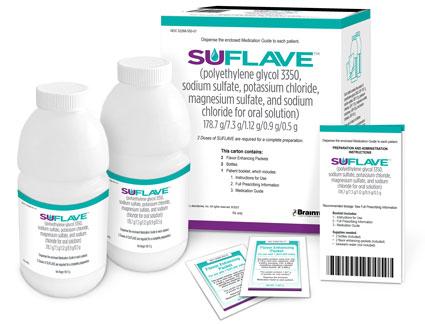Polyethylene Glycol 3350 With Electrolytes Dosage
Medically reviewed by Drugs.com. Last updated on Jun 12, 2024.
Usual Adult Dose for:
Usual Pediatric Dose for:
Additional dosage information:
Usual Adult Dose for Bowel Preparation
4 Liter preparations: 8 oz., orally, every 10 minutes, until the rectal effluent is clear or 4 liters are consumed OR 20 to 30 mL per minute via nasogastric tube
2 Liter preparations:
- Split-dose regimen: 8 oz., orally, every 15 minutes over 1 hour, then 0.5 L (approximately 16 oz.) of clear fluid the evening before colonoscopy
- Repeat this dosing the morning of the colonoscopy
- Evening only regimen: 8 oz., orally, every 15 minutes over 1 hour, the evening before the colonoscopy
- About 1.5 hours later: 8 oz., orally every 15 minutes over 1 hour
- An additional 1 liter (about 32 oz.) of clear liquid should be consumed the evening before the colonoscopy.
- Recommended start time is around 6 PM.
Comments:
- The product must be reconstituted prior to administration.
- Rapid drinking of each portion is preferred to drinking small amounts continuously.
- Avoid red and purple liquids when consuming clear fluids.
Use: Bowel cleansing prior to colonoscopy and barium enema X-ray examination
Usual Pediatric Dose for Bowel Preparation
6 months or older: 25 mL/kg/hour orally OR via nasogastric tube until the rectal effluent is clear
Comment: Not all products are approved for pediatric use; the manufacturer product information should be consulted.
Use: Bowel cleansing prior to colonoscopy and barium enema X-ray examination
Renal Dose Adjustments
Use with caution.
- Advise patients of the importance of adequate hydration.
- Consider performing baseline and post-procedure laboratory tests (electrolytes, creatinine, and BUN).
Liver Dose Adjustments
Data not available
Precautions
CONTRAINDICATIONS:
- Known allergy or hypersensitivity to the active components or to any of the ingredients
- Patients with bowel perforation
- Patients with gastrointestinal obstruction, gastric retention, or ileus
- Toxic colitis or toxic megacolon
Safety and efficacy have not been established in patients younger than 6 months.
Consult WARNINGS section for additional precautions.
Dialysis
Data not available
Other Comments
Administration advice:
- Product must be reconstituted prior to administration.
- Rapid drinking of each portion is preferred to drinking small amounts continuously.
- The patient should fast for 3 to 4 hours prior to starting this medication; no solid food should be given for at least 2 hours before the medication.
- Allow three hours for drinking and an additional hour for complete bowel evacuation.
- The solution is more palatable when chilled, but chilled solution is not recommended for infants.
Storage requirements:
- Store unreconstituted product at controlled room temperature.
Reconstitution/preparation techniques:
- If flavor packs are available, the preparation can be used with or without the flavor packs.
- If flavor packs are used, pour contents into bottle BEFORE reconstitution; shake well to incorporate flavoring into the powder.
- Add water to FILL line, replace cap tightly and shake well until all ingredients have dissolved.
- Do not add additional ingredients or flavorings to the solution.
- Dissolution is facilitated by using lukewarm water.
Patient advice:
- This medication produces a watery stool which cleanses the bowel prior to examination.
- Prepare the solution according to the package instructions.
- It is more palatable when chilled.
- For best results, don't consume solid food for 3 to 4 hours before drinking the solution; in no case should solid food be consumed within 2 hours of taking this medication.
- Continue drinking until the watery stool is clear and free of solid matter; this normally requires consuming 3 to 4 liters.
- Rapid drinking of each portion is better than drinking small amounts continuously.
- The first bowel movement occurs about 1 hour after starting this medication.
- If severe discomfort or distension occurs, stop drinking temporarily or drink each portion at longer intervals until the symptoms disappear.
- Oral medications taken within 1 hour of starting this medication may be flushed from the gastrointestinal tract and not absorbed.
- After the medication is taken, only clear liquids should be consumed. Avoid red and purple clear liquids.
- Discard any unused medication.
More about polyethylene glycol 3350 with electrolytes
- Check interactions
- Compare alternatives
- Reviews (1,139)
- Side effects
- During pregnancy
- Drug class: laxatives
Patient resources
- Polyethylene glycol electrolyte solution drug information
- Polyethylene glycol 3350, electrolytes, and ascorbic acid (Advanced Reading)
- Polyethylene glycol 3350, sodium and potassium salts (Advanced Reading)
- Polyethylene glycol 3350, sodium ascorbate, sodium sulfate, ascorbic acid, sodium chloride, and potassium chloride (Advanced Reading)
- Polyethylene Glycol-Electrolyte Solution (MoviPrep, Plenvu)
- Polyethylene Glycol-Electrolyte Solution Prep
Other brands
GoLYTELY, Plenvu, Suflave, GaviLyte-G, ... +7 more
Professional resources
- PEG-3350, Electrolytes and Ascorbate prescribing information
- PEG-3350, Sodium Chloride, Sodium Bicarbonate and Potassium Chloride (FDA)
- Polyethylene Glycol (FDA)
Other brands
GoLYTELY, Plenvu, Suflave, GaviLyte-G, ... +6 more
Related treatment guides
See also:
Further information
Always consult your healthcare provider to ensure the information displayed on this page applies to your personal circumstances.


